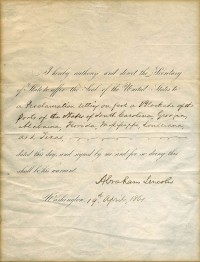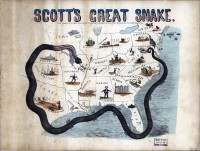 The document signed by President Abraham Lincoln on April 19, 1861 authorizing the Union Navy blockade of Southern ports is being sold by the anonymous private collector who owns it. You can buy it now for $900,000 through the website of high-end document dealer The Raab Collection. A strong, bold, authentic Lincoln autograph like the one signing this document would be highly sought after by collectors even if it were at the bottom of a shopping list. Having it attached to an order of immense historical and legal significance makes it a million dollar piece.
The document signed by President Abraham Lincoln on April 19, 1861 authorizing the Union Navy blockade of Southern ports is being sold by the anonymous private collector who owns it. You can buy it now for $900,000 through the website of high-end document dealer The Raab Collection. A strong, bold, authentic Lincoln autograph like the one signing this document would be highly sought after by collectors even if it were at the bottom of a shopping list. Having it attached to an order of immense historical and legal significance makes it a million dollar piece.
On April 12th, 1861, Confederate batteries unloaded on Fort Sumter, a sea fort in the harbor of Charleston, South Carolina. Although there had been shots fired earlier after South Carolina declared its secession from the Union in December of 1860, the 34-hour bombardment of federal forces at Fort Sumter is widely considered the beginning of the Civil War. According to the Supreme Court, however, the Civil War began on April 19th, 1861, the day President Lincoln issued the Proclamation of Blockade Against Southern Ports, an order directing the US Navy to prevent entrance and exit of vessels from all ports in the states of South Carolina, Georgia, Alabama, Florida, Mississippi, Louisiana, and Texas.
In its December Term of 1871, the Supreme Court adjudicated a case wherein to determine whether a statute of limitations applied, it was necessary to pinpoint the exact beginning and end dates of the Civil War. The Supreme Court’s determination was that the April 19th Proclamation of Blockade Against Southern Ports marked the legal opening of the Civil War in the states which it embraced. (A second proclamation issued on April 27th extended the blockade to Virginia and North Carolina, so according to the Supreme Court, the Civil War started eight days later in those two states of the Confederacy.) The end date for every state but Texas was April 2nd, 1866, the date President Andrew Johnson issued Proclamation 153 Declaring the Insurrection in Certain Southern States to be at an End. Texas’ war didn’t officially end until August 20th, 1866, when Johnson issued Proclamation 157 Declaring that Peace, Order, Tranquillity, and Civil Authority Now Exists in and Throughout the Whole of the United States of America.
The blockade proclamation was of momentous legal significance because it conferred belligerent status on the states in rebellion. You don’t blockade ports in your own country; you close them. Proclaiming a closure of ports in states where the federal government no longer held sway, however, would have been entirely empty since the Confederate authorities would obviously have kept their ports open. Port closures also do not allow for the legal search and seizure of neutral vessels. If the Union wanted to be able to intercept British ships coming and going from Confederate ports, by international law only a blockade would grant them the right to do so.
 There was much debate in Lincoln’s cabinet about whether the blockade proclamation was a bad idea, since it gave the Confederacy a legitimate position as belligerents which would allow them to make deals with neutral powers for loans and armaments. Lincoln decided that the blockade’s strategic importance as part of General Winfield Scott’s Anaconda Plan to strangle the South’s economy by cutting off their access to coastal and Mississippi ports essential to trade superseded the concerns about legal status. The president made a point, however, of never referring to the states as belligerents in the proclamation itself. They’re described as “rebellious” or engaged in “insurrection.”
There was much debate in Lincoln’s cabinet about whether the blockade proclamation was a bad idea, since it gave the Confederacy a legitimate position as belligerents which would allow them to make deals with neutral powers for loans and armaments. Lincoln decided that the blockade’s strategic importance as part of General Winfield Scott’s Anaconda Plan to strangle the South’s economy by cutting off their access to coastal and Mississippi ports essential to trade superseded the concerns about legal status. The president made a point, however, of never referring to the states as belligerents in the proclamation itself. They’re described as “rebellious” or engaged in “insurrection.”
The Proclamation of Blockade Against Southern Ports itself is not the document on sale. What’s being sold for just short of a million dollars is the order signed by Abraham Lincoln directing the Secretary of State to affix the U.S. seal to the proclamation. That affixing of the seal is what gives the presidential order the force of law. This simple document is a pre-printed blank authorization form that directs the affixing of the seal to an order which is described in a field filled in by hand as “a Proclamation setting on foot a Blockade of the ports of the States of South Carolina, Georgia, Alabama, Florida, Mississippi, Louisiana, and Texas.” The president signed the document and the Proclamation, complete with seal, was issued that same day.
If you’re wondering how it’s even possible that a document marking such a pivotal moment in United States history is in private hands rather than in a government archive, then you’re not alone. I wondered the same thing and asked Nathan Raab, Vice President of The Raab Collection, how it came to be in private hands. It turns out that these seal-affixing documents, orders from a president that an official proclamation with the Seal of the United States be released, appear on the market with some regularity. Often they were sold or disposed of by the government to raise funds or to make space for the official proclamations commissioned in the orders. In the early 20th century, these sorts of documents could be easily bought from book sellers and antiques shops for modest prices.
Most of them treat with less significant subjects — presidential pardons and diplomatic correspondence, for instance — but every once in a while an “affix the seal” of major historical import turns up. The “affix the seal” order for the Emancipation Proclamation was purchased in 2001 by the Chicago History Museum for one million dollars. The seal-affixing order for the preliminary Emancipation Proclamation is in the Hawaii State Archives and nobody knows how it got there. The working theory is it was donated by Bruce Cartwright, Jr., a Hawaiian businessman and collector of historic documents who was a strong supporter of the state archive.
I don’t know if you’ve seen it yet, but this seems like an opportune thread to mention this in: the Smithsonian will be showing a new exhibition of the art and photography of the Civil War.
I hadn’t seen that. It looks like it’s very much worth a visit. :thanks:
I seem to remember that Scott didn’t come up with the plan, he named it that derisively.
It was his plan, most definitely. The name was derisive, though, invented by the press who wanted a more glamorous, active, aggressive strategy than a slow strangulation of the South’s economy.
It was from a history mag I used to read and no longer have. There isn’t any way for me to go back and check. Maybe I’ve just misremembered what ot said.
I guess I can understand wanting to own a piece of history like the Blockade Order, but you would think anyone who really loves history would want to make that available to a museum, or such, so that the public could enjoy it…
I feel the same way. The good news is the current owner has loaned the order to several museums over the years. Hopefully the new owner will see fit to do the same.